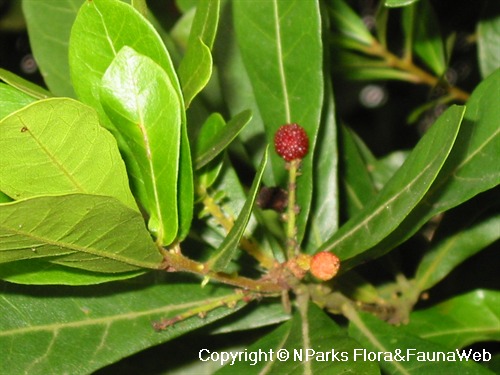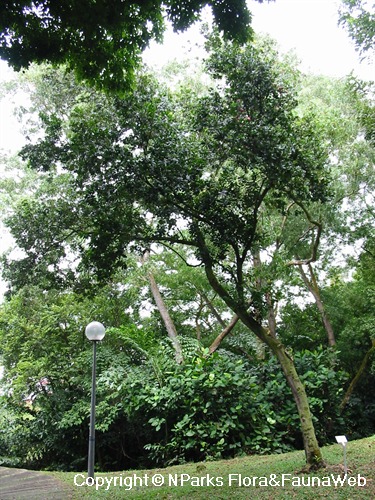
Back
Morella esculenta (Buch.-Ham. ex D.Don) I.M.Turner
| Family Name: | Myricaceae |
| Synonyms: | Myrica esculenta Buch.-Ham. ex D.Don |
| Common Name: | Malay Gale, Telur Cicak, Geliche, Telur Chichak, 毛杨梅 |
Name
Classifications and Characteristics
| Plant Division | Angiosperms (Flowering Seed Plants) (Dicotyledon) |
|---|---|
| Plant Growth Form | Tree (Small (6m-15m)) |
| Lifespan (in Singapore) | Perennial |
| Mode of Nutrition | Autotrophic |
| Plant Shape | Irregular |
| Maximum Height | 15 m |
Biogeography
| Native Distribution | Northern India, Myanmar, Vietnam, Thailand, Peninsular Malaysia, Singapore, the Philippines, Indonesia, Borneo, and Java |
|---|---|
| Native Habitat | Terrestrial (Primary Rainforest, Secondary Rainforest, Freshwater Swamp Forest) |
| Preferred Climate Zone | Tropical, Sub-Tropical / Monsoonal |
| Local Conservation Status | Native to Singapore (Least Concern (LC)) |
Description and Ethnobotany
| Growth Form | It is a tree up to 15 m tall. |
|---|---|
| Foliage | Its spirally-arranged, stalked leaves have leathery leaf blades that are lance-shaped-drop-shaped or oblong-drop-shaped, dark green above, pale green below, and 5–18 by 1–4.5 cm. Its young leaves are pale green with pink undersides. Its midrib is prominent below. |
| Flowers | Its male flowering shoots are 4–9 cm long and many branched, while its female flowering shoots are 1–3.5 cm long and bear many flowers. Both male and female flowering shoots grow in the leaf axils. Its flower-associated modified leaves are egg-shaped-triangular and about 1.25 mm long. |
| Fruit | Its fruits are ellipsoid, red, and about 1–2 cm long. Each fruit contains 1 seed. |
| Habitat | It grows on dry, well-drained soils and soil rich in iron and aluminum, in forests and sand dunes, up to 1700 m altitude. |
| Associated Fauna | It is the preferred local food plant for caterpillars of the moth Phyllonorycter myricae. It fruits are eaten by birds and other mammals. |
| Cultivation | It can be propagated by seed. |
| Etymology | Latin Morella, most likely from Morus, the mulberry genus; Latin esculenta, edible or good to eat |
| Ethnobotanical Uses | Edible Plant Parts : Edible Fruits Food (Fruit or Vegetable) Timber & Products: It is used as fuelwood. Others: Its bark has good tanning properties. |
Landscaping Features
| Landscaping | It is suitable for parks and streetscapes. |
|---|---|
| Landscape Uses | Suitable for Roadsides, Parks & Gardens |
Fauna, Pollination and Dispersal
| Fauna Pollination Dispersal Associated Fauna | Bird-Attracting, Caterpillar Moth Food Plant |
|---|---|
| Pollination Method(s) | Biotic (Fauna) |
| Seed or Spore Dispersal | Biotic (Fauna) |
Plant Care and Propagation
| Light Preference | Full Sun |
|---|---|
| Water Preference | Moderate Water |
| Plant Growth Rate | Moderate |
| Rootzone Tolerance | Moist Soils, Well-Drained Soils, Poor Infertile Soils, Fertile Loamy Soils |
| Propagation Method | Seed |
Foliar
| Foliage Retention | Evergreen |
|---|---|
| Mature Foliage Colour(s) | Green |
| Mature Foliage Texture(s) | Leathery |
| Foliar Type | Simple / Unifoliate |
| Foliar Arrangement Along Stem | Spiral |
| Foliar Attachment to Stem | Petiolate |
| Foliar Shape(s) | Non-Palm Foliage (Obovate, Oblong, Oblanceolate) |
| Foliar Venation | Pinnate / Net |
| Foliar Margin | Entire |
| Leaf Area Index (LAI) for Green Plot Ratio | 3.0 (Tree - Intermediate Canopy) |
Floral (Angiosperm)
| Flower & Plant Sexuality | Unisexual Flowers , Dioecious |
| Flower Colour(s) | Red, Yellow / Golden |
|---|
| Flower Grouping | Cluster / Inflorescence |
| Flower Location | Axillary |
| Flower Symmetry | Radial |
Fruit, Seed and Spore
| Mature Fruit Colour(s) | Red |
|---|---|
| Fruit Classification | Simple Fruit |
| Fruit Type | Fleshy Fruit , Non-Accessory Fruit |
Image Repository
Others
| Master ID | 1739 |
|---|---|
| Species ID | 3032 |
| Flora Disclaimer | The information in this website has been compiled from reliable sources, such as reference works on medicinal plants. It is not a substitute for medical advice or treatment and NParks does not purport to provide any medical advice. Readers should always consult his/her physician before using or consuming a plant for medicinal purposes. |

